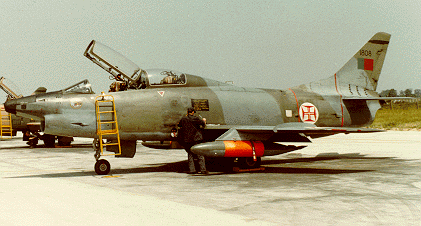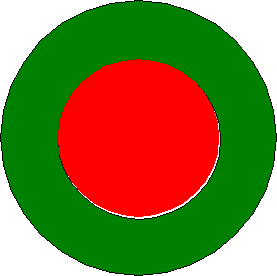

If so desiring you can proceed directly to :
Aviação Naval (Portuguese Naval Aviation)
Força
Aérea Portuguesa (Portuguese Air Force)
Below is presented then the history of the :
Arma de Aeronáutica
Although aircraft had been introduced in Portugal before 1914, to be used by the Army it is only at that date with the official creation of the EAM - Escola de Aeronáutica Militar (School of Military Aeronautics) in May 14, 1914, that begins the long history of military aviation in Portugal.
The school, located at Vila Nova da Rainha near Lisbon, only started to operate in 1916, the first flight taking place on July 17, 1916 in a Deperdussin piloted by Santos Leite.
In 1918 the Serviço Aeronáutico Militar (Military Aeronautical Service) was reorganized with six different departments, among them the EAM, and the Parque de Material Aeronáutico (Aeronautical Material Depot) embryo of the future Air Force workshops - OGMA.
The first operational unit was created in 1919 at Amadora (north of Lisbon) and was called Grupo de Esquadrilhas de Aviação República ( Republica Flight Group), with Esquadrilhas de Combate (Fighter flights) equipped with Spad's and Esquadrilhas de Bombardeamento e Observação (Bomber and Recce Flights) equipped with Breguet 14.
Meanwhile, in 1917 due to the war situation in Africa , an expeditionary force was dispatched to Moçambique equipped with Farman F.40 , staying there for some years. In addition, 9 Caudron G-3 were sent by sea to the Portuguese colony of Angola where they arrived in September 17, 1918, at the Moçâmedes port in the southern coast.
They formed the Esquadrilha Expedicionária
do Lubango (Lubango Expeditionary Flight) at the town of Lubango.
However due to the lack of appropriate fuel,
only in January 1923 flight activity was started. By that time they had
also received 9 Breguet 14's. In 1926 due
mainly to the lack of funds, the military aviation in Angola was extinguished
and the remaining material sent back to Portugal.
In September 1924 another chapter was opened with the complete restructuring of the Portuguese military aviation depending from the Army. Army Aviation was for the first time, recognized as a full capable branch, and received the name of Arma de Aeronáutica.
In 1925 the operational flying units were organized as follows:
- 1 Regimento de Aviação de Caça (Fighter Air Regiment) with 2 Grupos (Groups). Each Grupo should be composed by Esquadrilhas (Flights)
- 1 Regimento de Aviação de Bombardeamento (Bomber Air Regiment) with 2 Grupos.
- 2 Grupos de Aviação de Observação. (Air Observation Groups)
- 1 Esquadrilha de Aviação de Treino e Depósito (Air Training and Depot Flight).
By this time already two bases were operating : one near Sintra, since February 1920, and which received the Escola de Aeronáutica Militar (EAM), and another at Tancos since 1921, besides the workshops already located at Alverca as today. Amadora was still in use.
In 1927 the operational flying units were:
Grupo Independente de Aviação de Bombardeamento (Independent Bomber Group ) at Amadora
Grupo Independente de Aviação de Protecção e Combate (Independent Escort and Fighter Group) at Tancos.
Grupo de Aviação de Informação
(Air Reconnaissance Group) previously at Amadora but to be based at Alverca.
It
was however in 1937 with the approach of Second World War that occurs the
biggest reorganization of the military aviation. This coincides also with
the imminent reception of different types of aircraft bought in England
Italy and Germany to modernize the well worn flying units, equipped with
aircraft completely outdated.
The Decree nr.28401 of 31/12/37 stated that the "Aeronáutica
Militar Portuguesa" in peace time was to be composed of:
The fighter squadrons would have 15 aircraft, the bomber squadrons 5 aircraft, and the reconnaissance squadrons 9 aircraft.
Three Bases Aéreas were established: Sintra, Ota and Tancos, and a Campo Base - Lisbon. As a remark, the designation by numbers, that is Base Aérea 1-Sintra, was to be adopted only in 1940. The air units assigned to Amadora and Alverca were disbanded in 1938.
By this time had been, or were in process of being ordered, a large
quantity of new aircraft : Hawker Hind, Hawker Fury, DH-84 Dragon, JU-52,
JU-86, Gloster Gladiator, Breda Ba-65, to equip the newly created units
. The Portuguese Government also wanted to order 12 Spitfire I, but the
request was turned down, and instead Gladiator aircraft were supplied.
As a consequence of the W.W.II, in June 4, 1941 the steamship
"Mirandela" left Lisbon for the São Miguel Island in the Açores
(Azores) loaded with 30 Gladiator and five Ju-52 aircraft, support material
and personnel.
The Ju-52 were assigned to Rabo de Peixe Aerodrome in S.Miguel,
together with 15 Gladiator. These last ones formed the Esquadrilha
de Caça Expedicionária 1(Expeditionary Fighter Flight
1). The aerodrome was renamed Base Aérea 4 (Air Base .4). The second
group of Gladiators disembarked at Terceira Island, where
the Esquadrilha de Caça Expedicionária 2 (Expeditionary
Fighter Flight 2) was activated. In October 1941 the British supplied 12
Curtiss Mohawks which formed the Esquadrilha Expedicionária de
Caça 3 at São Miguel.
In 1943, and worried by the increase of German submarine operations in the Atlantic, the United Kingdom requested and obtained permission to operate anti-submarine aircraft from Terceira Island, which was done from the end of 1943 with the RAF 247th Group from Lajes Airfield in Terceira, built meanwhile.
Due to the granting of these facilities a steady flow of aircraft was sent from England to Portugal as part of payment for those facilities, and also considering the existing Alliance between the two countries since 1373.
Miles Masters, Martinets, and Magisters and Oxfords, were joined by
S.Spitfires I and V, Hawker Hurricanes IIB and IIc,  Bristol
Blenheims IV and V. For reconnaissance Westland Lysanders were received.
By these time flights were christened with two letter codes: the first
Spitfire flight formed at Tancos with eigtheen S.Spitfire I was the
Esquadrilha XZ.
Bristol
Blenheims IV and V. For reconnaissance Westland Lysanders were received.
By these time flights were christened with two letter codes: the first
Spitfire flight formed at Tancos with eigtheen S.Spitfire I was the
Esquadrilha XZ.
Another source of material were the many aircraft that force landed mainly at Lisbon, due to lack of fuel or combat damage : for instance the Esquadrilha OK was formed at Ota with 18 Bell Airacobras and one P-38 Lightning, which had landed at the end of 1942 at Portela Airport when flying to North Africa to participate in Operation Torch !
So at the end of W.W. II the Aeronáutica Militar
had around 240 operational aircraft, an interesting number for the time
and country size.
After the war, the first important event was the creation at Lajes in the Azores of the Search and Rescue Flight equipped with 5 SB-17G and 3 C-54 Skymasters.
The beginning of the separation from the Army was set with the publication
of Decree 37909 in August 1, 1950, which created the Subsecretariado
de Estado da Aeronáutica (Subsecretary of State for Aeronautics).
- Aviação Portuguesa - Albino Lapa
- 1928
- Presença da Força Aérea
em Angola - Edgar Cardoso - 1963
- 50 anos de Aviação Militar -
OGMA - 1964
- MAIS ALTO - Special Edition - May 1964 - Cinquentenary
of FAP
- Força Aérea Portuguesa - July
1966 - FAP edition
- Escola de Aeronáutica Militar - OGMA
Edition - 1967
- História da Força Aérea
Portuguesa - 3º Volume - Edgar Cardoso - 1984
- Bordo de Ataque - José Krus Abecasis
-Coimbra - 1985
